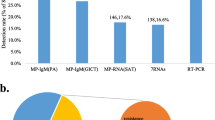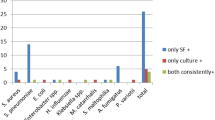Abstract
Mycoplasma pneumoniae (M. pneumoniae) is an important community-acquired pneumonia pathogen. Serological test and polymerase chain reaction (PCR) assay are the two main laboratory tests to detect M. pneumoniae now. Little information was compared about the sensitivity and specificity of PCR using different specimens including bronchoalveolar lavage (BAL) and nasopharyngeal aspirate (NPA). The aim of the present study was to evaluate diagnostic values of different specimens by fluorescence quantitative real-time PCR and to find clinical features helpful to diagnose M. pneumoniae pneumonia (MPP). Four hundred and six hospitalized pneumonia children were studied. M. pneumoniae DNA in NPA and BAL samples were detected by fluorescence quantitative real-time PCR. M. pneumoniae-specific IgM was tested by ELISA. MPP were diagnosed based on positive M. pneumoniae-specific IgM in 101 (24.9%) children. The median ages of MPP and non-MPP children were 4.1 and 2.4 years, respectively, with significant difference between them (p < 0.001). Laboratory results including leukocyte count, neutrophil percentage, immunoglobulins, except serum IgM, subgroups of T lymphocyte, and BAL cell count had no significant differences in MPP and non-MPP. BAL macrophage cell percentage was lower in BAL-PCR positive children (p = 0.003), while BAL neutrophil percentage was higher in BAL-PCR positive children (p = 0.007). PCR from NPA and BAL were similar in diagnostic parameters, including sensitivity, specificity, PPV, and NPV (78.6%, 63.4%, 39.8%, and 90.6% for NPA-PCR, respectively; 70.3%, 58.7%, 36.0%, and 85.6% for BAL-PCR, respectively). Conclusions: NPA is better than BAL as PCR sample in MPP diagnosis for similar performance in PCR assay, cheap, and less invasive. BAL is useful in defining local inflammatory condition. Age is the only prefigurative factor in MPP.

Similar content being viewed by others
Abbreviations
- BAL:
-
Bronchoalveolar lavage
- CAP:
-
Community-acquired pneumonia
- ELISA:
-
Enzyme-linked immunosorbent assay
- FOB:
-
Fiberoptic bronchoscopy
- IL:
-
Interleukin
- M. pneumoniae :
-
Mycoplasma pneumoniae
- MPP:
-
M. pneumoniae pneumonia
- Non-MPP:
-
Pneumonia not caused by M. pneumoniae
- NPA:
-
Nasopharyngeal aspirate
- NPV:
-
Negative prediction value
- PCR:
-
Polymerase chain reaction
- PPV:
-
Positive prediction value
- ROC:
-
Relative operating characteristic
References
Abu-Diab A, Azzeh M, Ghneim R et al (2008) Comparison between pernasal flocked swabs and nasopharyngeal aspirates for detection of common respiratory viruses in samples from children. J Clin Microbiol 46(7):2414–7
Beersma MF, Dirven K, van Dam AP, Templeton KE, Claas EC, Goossens H (2005) Evaluation of 12 commercial tests and the complement fixation test for Mycoplasma pneumoniae-specific immunoglobulin G (IgG) and IgM antibodies, with PCR used as the “gold standard”. J Clin Microbiol 43(5):2277–85
British, T.S.o.S.o.C.C. (2002) British thoracic society guidelines for the management of community acquired pneumonia in childhood. Thorax 57(Suppl 1):i1–24
Daxboeck F, Krause R, Wenisch C (2003) Laboratory diagnosis of Mycoplasma pneumoniae infection. Clin Microbiol Infect 9(4):263–73
Dorigo-Zetsma JW, Zaat SA, Vriesema AJ, Dankert J (1999) Demonstration by a nested PCR for Mycoplasma pneumoniae that M. pneumoniae load in the throat is higher in patients hospitalised for M. pneumoniae infection than in non-hospitalised subjects. J Med Microbiol 48(12):1115–22
Fischer JE, Steiner F, Zucol F et al (2002) Use of simple heuristics to target macrolide prescription in children with community-acquired pneumonia. Arch Pediatr Adolesc Med 156(10):1005–8
Ginevra C, Barranger C, Ros A et al (2005) Development and evaluation of Chlamylege, a new commercial test allowing simultaneous detection and identification of Legionella, Chlamydophila pneumoniae, and Mycoplasma pneumoniae in clinical respiratory specimens by multiplex PCR. J Clin Microbiol 43(7):3247–54
Gullsby K, Storm M, Bondeson K (2008) Simultaneous detection of Chlamydophila pneumoniae and Mycoplasma pneumoniae by use of molecular beacons in a duplex real-time PCR. J Clin Microbiol 46(2):727–31
Honda J, Yano T, Kusaba M et al (2000) Clinical use of capillary PCR to diagnose Mycoplasma pneumonia. J Clin Microbiol 38(4):1382–4
Kamizono S, Ohya H, Higuchi S, Okazaki N, Narita M (2010) Three familial cases of drug-resistant Mycoplasma pneumoniae infection. Eur J Pediatr 169(6):721–6
Kashyap B, Kumar S, Sethi GR, Das BC, Saigal SR (2008) Comparison of PCR, culture and serological tests for the diagnosis of Mycoplasma pneumoniae in community-acquired lower respiratory tract infections in children. Indian J Med Res 128(2):134–9
Kim NH, Lee JA, Eun BW et al (2007) Comparison of polymerase chain reaction and the indirect particle agglutination antibody test for the diagnosis of Mycoplasma pneumoniae pneumonia in children during two outbreaks. Pediatr Infect Dis J 26(10):897–903
Lee KY (2008) Pediatric respiratory infections by Mycoplasma pneumoniae. Expert Rev Anti Infect Ther 6(4):509–21
Linchevski I, Klmenet E, Nir-Paz R (2009) Mycoplasma pneumoniae vaccine protective efficacy and adverse reactions—systematic review and meta-analysis. Vaccine 27(18):2437–46
Loens K, Ieven M, Ursi D et al (2003) Detection of Mycoplasma pneumoniae by real-time nucleic acid sequence-based amplification. J Clin Microbiol 41(9):4448–50
Loens K, Ursi D, Goossens H, Ieven M (2003) Molecular diagnosis of Mycoplasma pneumoniae respiratory tract infections. J Clin Microbiol 41(11):4915–23
Loens K, Van Heirstraeten L, Malhotra-Kumar S, Goossens H, Ieven M (2009) Optimal sampling sites and methods for detection of pathogens possibly causing community-acquired lower respiratory tract infections. J Clin Microbiol 47(1):21–31
Macfarlane P, Denham J, Assous J, Hughes C (2005) RSV testing in bronchiolitis: which nasal sampling method is best. Arch Dis Child 90(6):634–5
McIntosh K (2002) Community-acquired pneumonia in children. N Engl J Med 346(6):429–37
Nadal D, Bossart W, Zucol F et al (2001) Community-acquired pneumonia in children due to Mycoplasma pneumoniae: diagnostic performance of a seminested 16S rDNA-PCR. Diagn Microbiol Infect Dis 39(1):15–9
Narita M (2010) Pathogenesis of extrapulmonary manifestations of Mycoplasma pneumoniae infection with special reference to pneumonia. J Infect Chemother 16(3):162–9
Nilsson AC, Bjorkman P, Persson K (2008) Polymerase chain reaction is superior to serology for the diagnosis of acute Mycoplasma pneumoniae infection and reveals a high rate of persistent infection. BMC Microbiol 8:93
Ou ZY, Zhou R, Wang FH et al (2008) Retrospective analysis of Mycoplasma pneumoniae infection in pediatric fatal pneumonia in Guangzhou, South China. Clin Pediatr 47(8):791–6
Raty R, Ronkko E, Kleemola M (2005) Sample type is crucial to the diagnosis of Mycoplasma pneumoniae pneumonia by PCR. J Med Microbiol 54(Pt 3):287–91
Sanchez-Vargas FM, Gomez-Duarte OG (2008) Mycoplasma pneumoniae—an emerging extra-pulmonary pathogen. Clin Microbiol Infect 14(2):105–17
Skakni L, Sardet A, Just J et al (1992) Detection of Mycoplasma pneumoniae in clinical samples from pediatric patients by polymerase chain reaction. J Clin Microbiol 30(10):2638–43
Stralin K, Korsgaard J, Olcen P (2006) Evaluation of a multiplex PCR for bacterial pathogens applied to bronchoalveolar lavage. Eur Respir J 28(3):568–75
Tang LF, Shi YC, Xu YC, Wang CF, Yu ZS, Chen ZM (2009) The change of asthma-associated immunological parameters in children with Mycoplasma pneumoniae infection. J Asthma 46(3):265–9
Templeton KE, Scheltinga SA, Graffelman AW et al (2003) Comparison and evaluation of real-time PCR, real-time nucleic acid sequence-based amplification, conventional PCR, and serology for diagnosis of Mycoplasma pneumoniae. J Clin Microbiol 41(9):4366–71
Thurman KA, Walter ND, Schwartz SB et al (2009) Comparison of laboratory diagnostic procedures for detection of Mycoplasma pneumoniae in community outbreaks. Clin Infect Dis 48(9):1244–9
Waites KB, Talkington DF (2004) Mycoplasma pneumoniae and its role as a human pathogen. Clin Microbiol Rev 17(4):697–728, table of contents
Waris ME, Toikka P, Saarinen T et al (1998) Diagnosis of Mycoplasma pneumoniae pneumonia in children. J Clin Microbiol 36(11):3155–9
Winchell JM, Thurman KA, Mitchell SL, Thacker WL, Fields BS (2008) Evaluation of three real-time PCR assays for detection of Mycoplasma pneumoniae in an outbreak investigation. J Clin Microbiol 46(9):3116–8
Woodhead M, Blasi F, Ewig S et al (2005) Guidelines for the management of adult lower respiratory tract infections. Eur Respir J 26(6):1138–80
Yu J, Yoo Y, Kim DK, Kang H, Koh YY (2005) Distributions of antibody titers to Mycoplasma pneumoniae in Korean children in 2000–2003. J Korean Med Sci 20(4):542–7
Acknowledgments
The authors thank all patients and guardians involved in the study. We also thank all colleagues in central laboratory of our hospital and doctors who have enrolled patients. This study was partially supported by grants from the National Natural Science Foundation of China (nos. 30872798, 81070004, and 81000765).
Conflict of interest
There was no conflict of interest.
Author information
Authors and Affiliations
Corresponding authors
Rights and permissions
About this article
Cite this article
Xu, D., Li, S., Chen, Z. et al. Detection of Mycoplasma pneumoniae in different respiratory specimens. Eur J Pediatr 170, 851–858 (2011). https://doi.org/10.1007/s00431-010-1360-y
Received:
Accepted:
Published:
Issue Date:
DOI: https://doi.org/10.1007/s00431-010-1360-y




